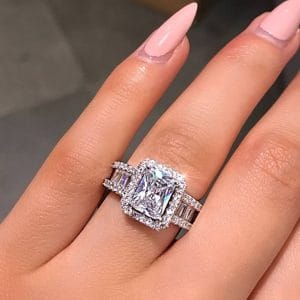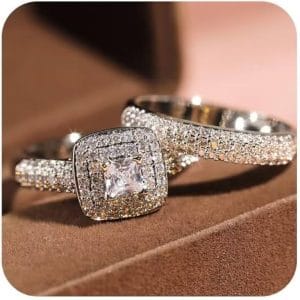Revolution: Why Silver and Diamonds are the New Power Couple in Fine Jewelry

The landscape of fine jewelry is undergoing a seismic, yet elegant, transformation. For centuries, the pairing of diamonds was almost exclusively reserved for gold and platinum—metals whose sheer monetary value matched the perceived intrinsic worth of a mined diamond. Today, however, a dynamic and increasingly dominant trend is shifting the paradigm: the brilliant union of sterling silver and diamonds, specifically, high-quality synthetic, or lab-grown, diamonds. This combination is not merely a passing fad; it represents a revolution in accessible luxury, ethical consumerism, and modern design, democratizing the coveted sparkle of a diamond like never before.
The Dawn of Accessible Luxury: Synthetic Diamonds Meet Sterling Silver
The core of this growing trend is a fusion of two powerful and compelling attributes: the unparalleled beauty and durability of a real diamond, and the affordability and design versatility of sterling silver.

The Rise of the Synthetic Diamond
To understand the trend, one must first recognize the evolution of the synthetic diamond. Often referred to as lab-grown or man-made diamonds, these stones are chemically, physically, and optically identical to their mined counterparts. Created in controlled laboratory environments using either the High-Pressure/High-Temperature (HPHT) or Chemical Vapor Deposition (CVD) method, these diamonds offer the exact same fire, brilliance, and hardness (a perfect 10 on the Mohs scale) as those unearthed from the earth.
The key distinction lies in their origin and, crucially, their price. By bypassing the immense costs and complex supply chains associated with mining, synthetic diamonds can be offered to consumers at a fraction of the price—often 30% to 50% less—of a comparable natural stone. This financial accessibility has dramatically lowered the entry point for owning genuine, high-carat diamond jewelry.
Sterling Silver: The Perfect Complement

Silver, particularly sterling silver (92.5% pure silver alloyed with other metals for strength, commonly stamped with ‘925’), is a timeless precious metal with its own distinguished history in jewelry. For generations, it has been cherished for its bright, white luster and its supreme malleability, which allows artisans to execute intricate and bold designs that might be cost-prohibitive in gold or platinum.
When paired with the bright, colorless brilliance of a lab-grown diamond, sterling silver provides an ideal, clean, and modern backdrop. The white-on-white aesthetic beautifully complements the diamond’s fire, creating a sophisticated look that resonates with a new generation of buyers seeking luxury that aligns with sensibility. The sheer cost-effectiveness of sterling silver, compared to gold, amplifies the savings realized from the synthetic diamond, making a substantial, show-stopping piece of jewelry attainable for a wider audience.
Driving Forces Behind the Pairing Trend
Several market forces and shifts in consumer behavior are fueling the explosive growth of jewelry featuring silver and diamonds.
1. The Ethical and Sustainable Imperative
Modern consumers, particularly Millennials and Gen Z, are increasingly making purchasing decisions based on ethical sourcing and environmental impact. The diamond mining industry has historically faced scrutiny over environmental disruption, labor practices, and the funding of conflicts (the issue of ‘blood diamonds’).
Synthetic diamonds, by contrast, offer a transparent, traceable, and guaranteed conflict-free alternative. While the labs consume energy, their overall environmental footprint is generally acknowledged to be significantly smaller than that of traditional mining operations. The pairing with silver, a metal that is often more readily recycled and has a lower overall environmental impact in its sourcing, creates a compelling value proposition for the eco-conscious shopper: the assurance of an ethical, sustainable, and beautiful product.
2. Affordability and Design Freedom
The cost structure of this combination has unleashed unprecedented creative freedom for both jewelers and consumers.
- For the Consumer: The lower material cost means that a budget once reserved for a small natural diamond set in a simple gold band can now purchase a much larger, higher-carat synthetic diamond set in a sophisticated silver design. This allows for grander statement pieces, more intricate pavé settings, and the ownership of multiple diamond pieces for different occasions, moving the diamond from a once-in-a-lifetime purchase to an accessible part of a modern jewelry wardrobe.
- For the Designer: Silver’s workability allows designers to experiment with complex geometric forms, sculptural settings, and larger surface areas of metal—designs that would be prohibitively expensive or too weighty in gold or platinum. This versatility has led to an outpouring of new, fashion-forward designs that blend the casual elegance of silver with the serious sparkle of a diamond.
3. Fashion and Versatility
The aesthetic of silver and diamonds speaks to contemporary fashion sensibilities. Silver’s bright, neutral tone is versatile, pairing effortlessly with both casual and formal wear. It offers a fresh, minimalist alternative to the warmer tones of yellow gold, appealing to those who prefer a clean, modern look. Furthermore, its use in high-end fashion jewelry brands has elevated its perception, positioning it not just as a cheaper alternative but as a material of choice for cutting-edge design.
Addressing Practicality: Maintenance and Durability
A common historical argument against setting large diamonds in silver was the metal’s comparative softness and its tendency to tarnish. While sterling silver is softer than gold or platinum, modern jewelry techniques have largely mitigated these concerns, particularly in the context of fashion and everyday wear.
- Rhodium Plating: Almost all sterling silver jewelry, especially that set with diamonds, is finished with a layer of rhodium plating. Rhodium, a member of the platinum group, is incredibly hard and brilliantly white. This plating dramatically increases the metal’s scratch resistance, enhances its shine, and—most importantly—prevents the silver from tarnishing, ensuring that the piece remains bright and clean, allowing the diamond’s brilliance to remain undiminished.
- Advanced Setting Techniques: Jewelers employ robust setting styles, such as secure bezels and thick, well-braced prongs, to ensure the synthetic diamond remains firmly in place. While large, everyday pieces like engagement rings traditionally favor gold or platinum for their superior longevity and maintenance characteristics, the silver and synthetic diamond pairing is perfect for a vast array of high-quality necklaces, earrings, bracelets, and fashion rings that do not face the continuous wear of a bridal set.
The Market Outlook: A Sustainable Trajectory
The market data confirms that the pairing of silver and diamonds—specifically the synthetic variety—is on a clear upward trajectory. Global synthetic diamond market growth is robust, driven by the jewelry sector where lab-grown stones are capturing a significant and growing share of consumer spend, especially in engagement and bridal categories. The increasing availability of these pieces on major e-commerce platforms and in traditional retail chains further solidifies their position as a mainstream jewelry choice.
In conclusion, the emergence of high-quality synthetic diamonds has provided the perfect technological and ethical catalyst for the renewed love affair between silver and diamonds. This powerful combination offers a compelling value proposition: the aspirational sparkle of a diamond with the conscious, attainable luxury of sterling silver. It is a brilliant convergence of ethics, economics, and aesthetics, signaling a new, more inclusive, and sustainable chapter for the entire fine jewelry industry. This trend is here to stay, sparkling its way across the necks, wrists, and fingers of a global clientele.
